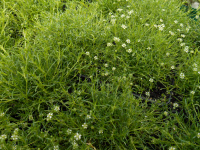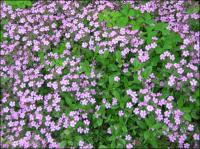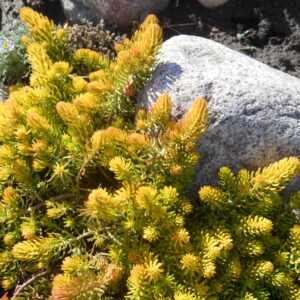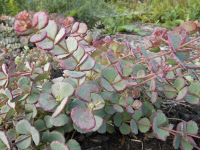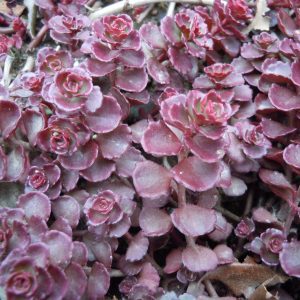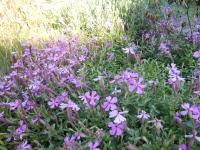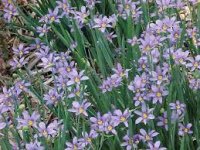Alpine, Rock, Miniature, Bonsai and Railroad Gardens
Showing 73–80 of 92 results
-
Sagina subulata Pearlwort, Irish moss Z 4-7
Tiny white flowers in summer on extra-miniature grass-like leaves
OUT OF STOCK
Tiniest of white flowers in summer on mound of extra-miniature grass-like leaves.
Size: ½” x 8”
Care: sun to part shade in moist well-drained soil
Native: CorsicaSagina subulata was discussed in Revue Horticole in 1896. The variety aurea extensively used for carpet bedding. H.H. Thomas, 1915. Perfect for rock gardens, between stepping stones on a path or as a groundcover.
-
Saponaria ocymoides Rock soapwort Z 4-9
Cheery pink soapwort, in late spring, hugs the ground
Cheery pink soapwort, in late spring, hugs the ground.
Size: 3" x 18"
Care: Sun, well-drained soil, cut back hard after flowering
Native: Spain to Yugoslavia
Awards: Received England’s Royal Horticultural Society Award of Merit.Both the botanical and common names come from the plant’s use as soap, the leaves “yeelde out of themselves a certain iuice when they are bruised, which scoureth almost as well as sope.” Gerard (1633). Soapwort is still used today by antique and art restorers for its gentle cleaning: chop dried leaves and roots, boil in water for 5 minutes, and then agitate to make suds. William Robinson, father of today’s mixed perennial border gardens, praised this as bearing “masses of rosy blooms.”
-
Sedum rupestre ‘Angelina’ syn. Sedum reflexum ‘Angelina’ Spruce-leaved stonecrop Z 4-8
Chartreuse, turning red-orange in fall, needle-like leaves blooming with yellow flowers June-August but the leaves are the feature.
Chartreuse, turning red-orange in fall, needle-like leaves blooming with yellow flowers June-August but the leaves are the feature.
Size: 4-6” x 1-2’ spreader
Care: sun in well-drained to moist well-drained soil.
Wildlife Value: Rabbit and Deer resistant. Drought tolerant.Species grown at America’s 1st botanic garden, Elgin Botanic Garden 1811
-
Sedum sieboldii syn Hylotelephium sieboldii, October Daphne Z 3-9
Fleshy gray-green foliage edged with pink encircles the prostrate stems, flowering strawberry pink in fall. Perfect for rock gardens, front of border, fairy gardens, roof gardens, troughs and groundcover or anyplace with drought.
Fleshy gray-green foliage edged with pink encircles the prostrate stems, flowering strawberry pink in fall. Perfect for rock gardens, front of border, fairy gardens, roof gardens, troughs and groundcover or anyplace with drought.
Size: 4" x 8"
Care: full sun in moderately fertile, well-drained soil.
Native: Japan
Wildlife Value: Drought tolerant and deer resistant.
Awards: Elisabeth Carey Miller Botanical Garden Great Plant PickSedum means “plant that sits.” “Live forever” is an ancient Greek name for sedums. The Roman Pliny claimed that sedum’s juice treated wounds. In the 1500’s English herbalist Gerard called sedums “very full of life,” referring to succulent’s quality of being very easy to grow. This species named for its discoverer, Dr. Philipp Franz von Siebold (1791-1866). Von Siebold, a German doctor, worked for the Dutch East India Company as its resident physician on Deshima Island, off the coast of Japan. He boldly became too knowledgeable about Japanese affairs and was imprisoned by the Japanese in 1826 and then banished in 1828. When he left he carried nearly 500 plants with him to Europe. William Robinson, father of the mixed perennial border, described Sedum sieboldii as beautiful. He advised gardeners to grow it “in strong loam and mortar rubble in fully exposed positions (and use it as) an excellent plant for vases in summer.”
-
Sedum spurium ‘Coccineum’ Dragon’s blood Z 4-9
Mat-forming evergreen. In spring red encircle its fleshy, green, round leaves. In summer leaves turn bronze and in fall deep burgundy. Small, bright pink, star-shaped flowers.
Mat-forming evergreen. In spring red encircle its fleshy, green, round leaves. In summer leaves turn bronze and in fall deep burgundy. Small, bright pink, star-shaped flowers.
Size: 4-6" x spreading 12-18"
Care: sun in well-drained to moist well-drained soil
Native: Caucasus Mountains
Awards: Royal Horticultural Society Award of Garden Merit; Great Plant PickFranklin Gardens in Big Springs Arkansas sold this in 1948 for 50 cents calling it “a new sedum. . . “Called “a new Sedum that will surely become popular” New and Noteworthy Hardy Plants Spring Flor-Acres’ Perennials 1950 p. 13
-
Sempervivum tectorum Hens and chicks Z 3-10
Rosettes of succulent leaves
OUT OF STOCK
Rosettes of succulent leaves
Size: 4” x 4”
Care: sun in well-drained to moist well-drained soil
Native: Alps & Pyrenees MountainsGrown in gardens for thousands of years. Sempervivum means “live forever.” Romans planted Hens and chicks on their roofs to ward off lightning. As a succulent it holds water and is probably more difficult to catch fire. “This practice was preserved for historians when Charlemagne (720-814), first Holy Roman Emperor and unifier of a large part of northern Europe, ordered that all villagers within his crown lands plant houseleeks on their roofs, presumably as a safety measure. He decreed: Et ille hortulanus habeat super domum suam Iovis barbam. (And the gardener shall have house-leeks growing on his house. Capitulare de villis, about 795, LXX.)”
-
Silene schafta Schaft’s catchfly, Moss Z 5-7
One of the spectacular late season blooms –clusters of five-petaled, jagged-edge, bright magenta flowers on short mounds, September to October. Perfect for front of borders or rock gardens.
OUT OF STOCK
One of the spectacular late season blooms –clusters of five-petaled, jagged-edge, bright magenta flowers on short mounds, September to October. Perfect for front of borders or rock gardens.
Size: 6” x Slowly spreading
Care: full sun in well-drained to moist well-drained soil
Native: Russia
Awards: England’s Royal Horticultural Society Award of MeritIntroduced from its native Russia in 1844. First described by and probably collected by Johann Gmelin (1709-1755) German naturalist who spent years hunting plants in Russia and authored four-volume Flora Sibirica. In Greek mythology Silene was a companion of Bacchus who was covered with foam. William Robinson, father of the mixed perennial border, described the flowers of this species as being “very neat tufts.”
-
Sisyrinchium angustifolium Blue eyed grass Z 3-9
Cutest petite iris-like foliage sporting blue saucer-shaped flowers with bright yellow stamens in summer.
Cutest petite iris-like foliage sporting blue saucer-shaped flowers with bright yellow stamens in summer.
Size: 12" x 6"
Care: Sun in well-drained soil
Native: North America, Wisconsin native.In cultivation by 1732. Named by Philip Miller, gardener of the Chelsea Botanic Garden, in Gardeners’ Dictionary .
Mahuna Indians of So. California made a tea from the entire plant to expel stomach worms.

